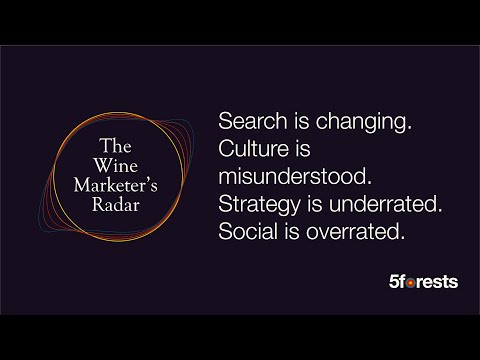This week, I’m recording from Verona! What better place than one of the world’s largest wine fairs to look at a few trends and tensions that wine needs to know but may be missing—from consumer expectations around search and relevance to the misuse of “culture” in strategy to a growing disconnect between what marketers say they value and where budgets actually go?
Let’s start with what consumers really, really want from search.
2025 State of Search report
According to the 2025 State of Search report by adMarketplace, consumers are getting used to search engines that know what they want — sometimes before they even finish typing. This report shows that 41% of people rely on relevance to find new products or brands.
Their top wish list items for improving search?
- Real-time results (38%)
- More relevant recommendations (34%)
- Predictive suggestions (23%)
Why? Because platforms like Amazon, TikTok, and YouTube are training consumers to expect smarter filters, context-aware suggestions, and fewer irrelevant results — not just in retail, but across every digital touchpoint.
Why it matters for wine:
This matters if your brand has a digital storefront with multiple SKUs or if you’re investing in discovery via search and content. Tools like Commerce7 allow wineries to offer smarter product recommendations, but only if you’ve got solid tagging and clean segmentation.
For leaner operations with only a few SKUs or tasting-room-first sales, this trend is less about tech and more about making sure your message shows up where it’s relevant and timely.
The big takeaway:
You don’t need AI to deliver relevance. You need clear categories, frictionless navigation, and content that reflects what your customer is actually trying to find.
Now, let’s talk about culture — and how marketers keep getting it wrong.
Culture in marketing
At the Brands & Culture NY event this week, marketers openly wrestled with the term “culture,” admitting it’s often easier to define what it ISN’T rather than what is IS. Despite the confusion, major brands like Diageo have made cultural relevance a central strategy pillar.
A great example is Captain Morgan. Traditionally targeted to older men, the brand recently launched a Sweet Chili Lime rum aimed at younger drinkers. This goes well beyond new flavor development—it is about engaging with what they believe younger consumers are actually interested in.
Why it matters for wine:
Wine has long equated “culture” with heritage. But today’s consumers (especially Gen Z) interpret culture as something fluid, lived, and identity-driven. If your brand still uses “culture” to mean aesthetics or storytelling, you’re missing the point.
Cultural marketing isn’t about chasing trends or TikTok dances. It’s about understanding how your brand fits into the lives people are actually living — and doing so in a way that’s baked into your product and planning, not just your creative.
Strategy is being sidelined
Next up, Marketing Week’s Career & Salary Survey results came out and marketers are saying something loud and clear: strategy is still being sidelined.
Nearly two-thirds of marketers believe strategic expertise is undervalued by their organizations, and that number rises to 73% among CMOs. For the third year in a row, strategy has topped the list of underappreciated skills, beating out brand management and data analysis.
This should hit home. Too many wine businesses treat marketing as execution-only — ads, emails, events, social posts — rather than investing in the strategic thinking that connects customer behavior to long-term business growth. Marketing strategy isn’t a luxury — it’s a competitive advantage. If your winery’s marketing feels reactive or repetitive, it’s time to ask not “What should we do next,” but “Why are we doing any of this?”
Social media is overrated
And finally, let’s address the elephant in the room: is social media overhyped? According to that same survey, the answer is a resounding “hell yeah.”
Marketers consistently rank social media as the most overrated skill — ahead of AI, SEO, and performance marketing. This tension has held for three years in a row.
Why? Possibly because social media is overhyped as a cure-all. Or maybe because the ROI has become harder to trust as platforms get noisier and more algorithmic.
Why it matters for wine:
Social media still matters — but the expectation that it should drive brand awareness, conversion, and community building all at the same time is flawed. For most wine brands, social media is best used as a visibility tool or storytelling extension — not a core sales driver.
My advice: Use social media for what it does well: building recognition and reinforcing your brand’s identity. But don’t overinvest in chasing engagement metrics at the expense of building actual customer relationships elsewhere.
That’s it for this week’s edition of The Wine Marketer’s Radar. If you find this series useful—and want to keep seeing smart, non-wine stories decoded for wine marketers—be sure to follow along on TikTok, YouTube, Spotify & Apple Podcasts.
The Radar is part of our ongoing effort to help winery DTC, brand, and marketing teams stay sharp in a fast-moving world. If you spot a trend worth talking about, drop us a line. If you need a hand with your wine marketing, get in touch.
